Abstract
1 The alpha-adrenoceptor of rat liver plasma membranes was studied by use of the specific alpha-antagonist [3H]-dihydroergocryptine ([3H]-DHEC). Catecholamines and adrenergic compounds displayed an order of affinity that is typical of an alpha-receptor. Nevertheless, protokylol, a potent beta-adrenoceptor agonist, exhibited a higher affinity than that of adrenaline for alpha-sites. This result might be due to its bulky substituent on the amino group. 2 Further displacement experiments between [3H]-DHEC and four pairs of drugs differently substituted on the amino group (isoprenaline vs Cc-25, orciprenaline vs fenoterol, AH 3474 vs labetalol, pindolol vs hydroxybenzylpindolol) provided evidence that N-alkyl substitution decreased the affinity for alpha-sites (20 micromolar less than KD less than 200 micromolar), whereas an N-aralkyl one increased the affinity (0.17 micromloar less than KD less than 4.6 micromolar). 3 It is concluded that a substitution on the amino group by a bulky, hydrophobic moiety enhances the affinity of drugs for the alpha-adrenoceptors.
Full text
PDF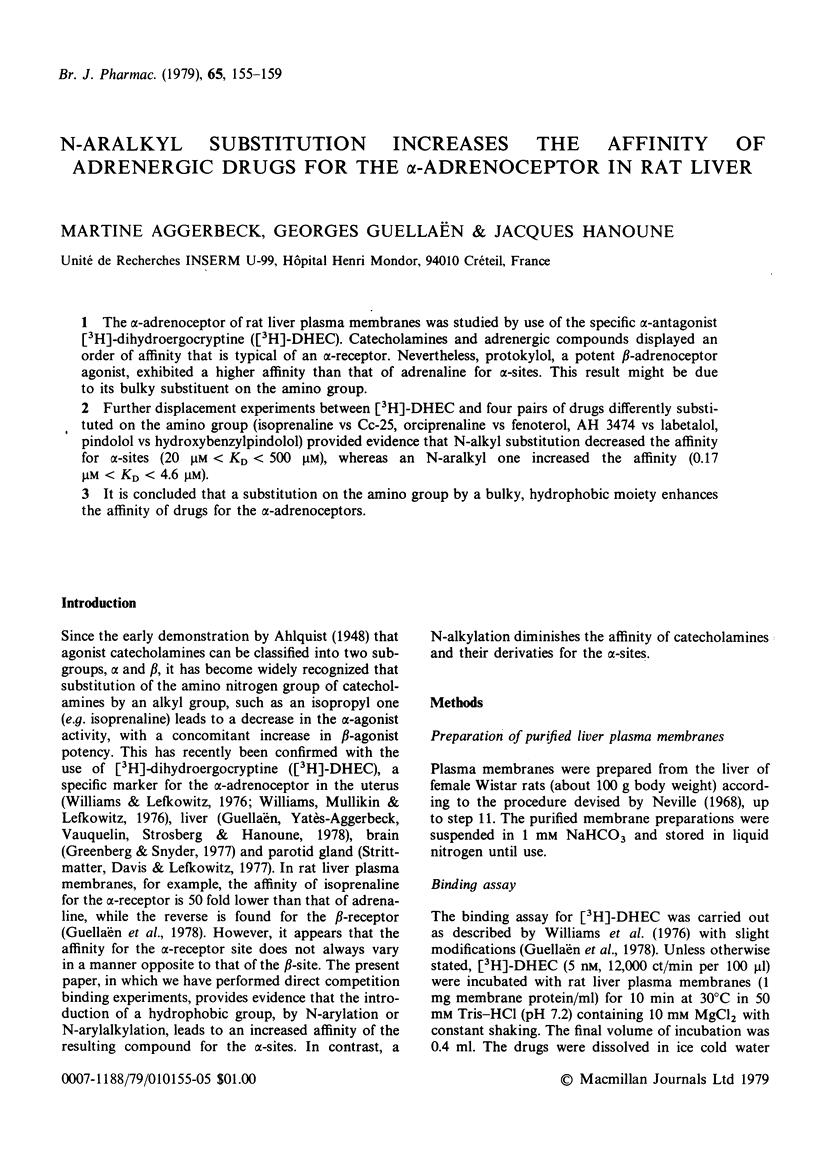
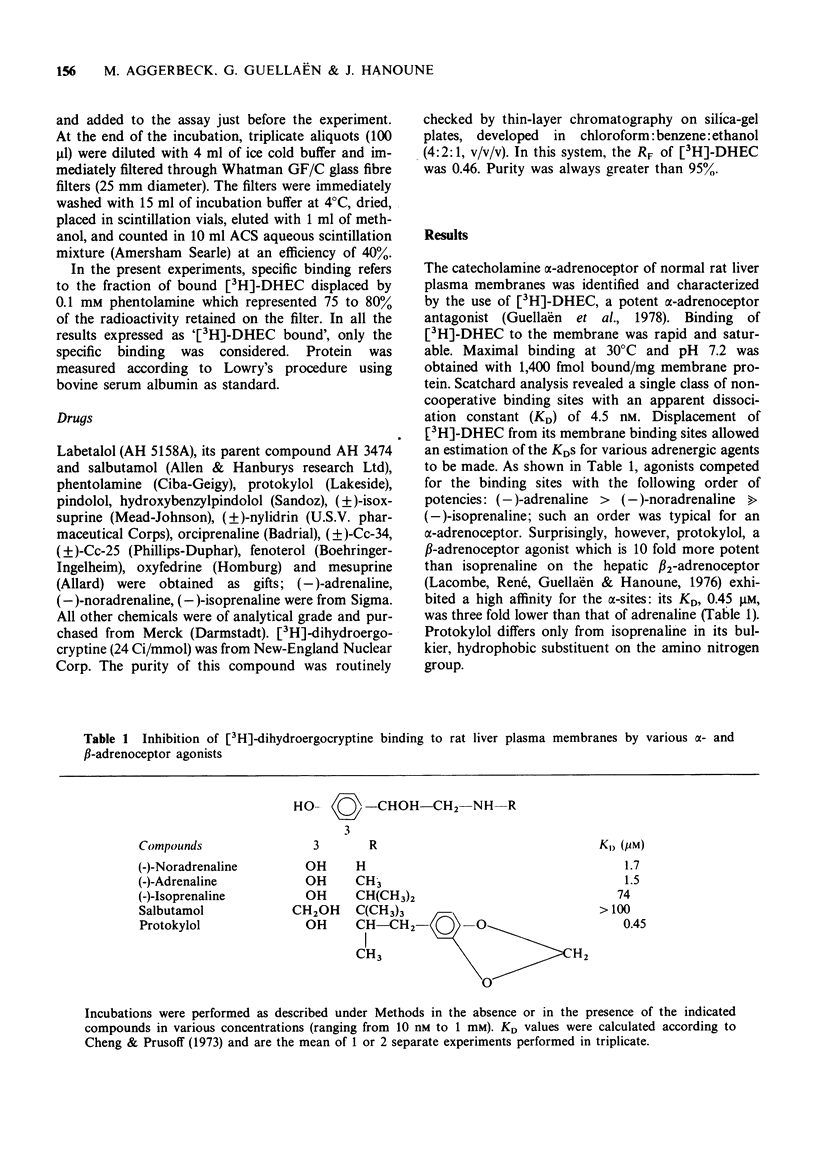
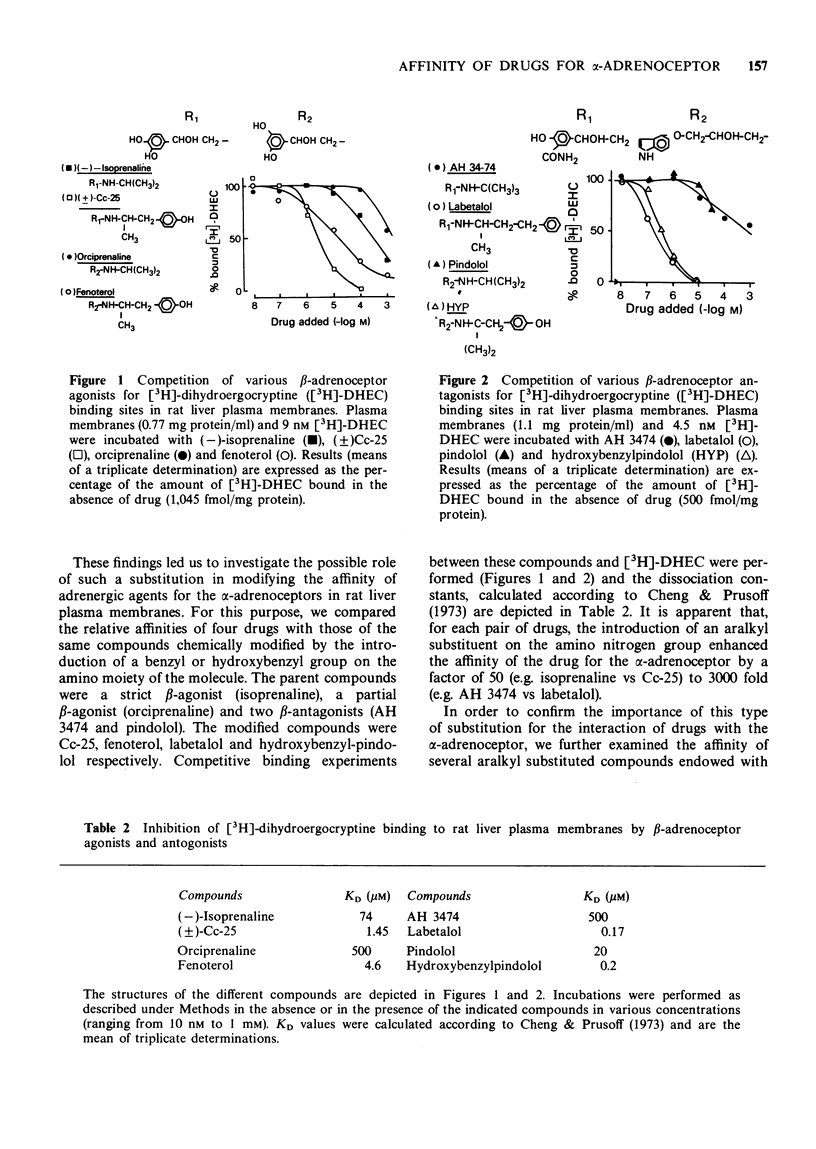
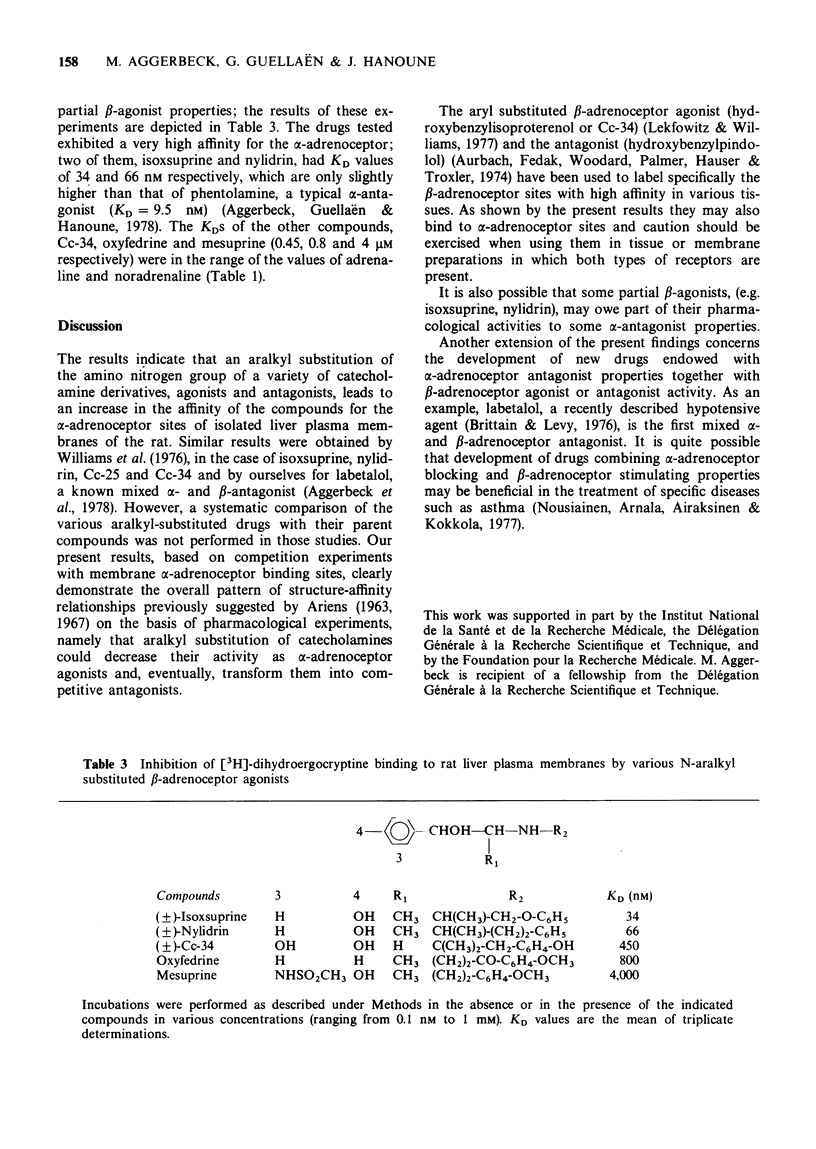
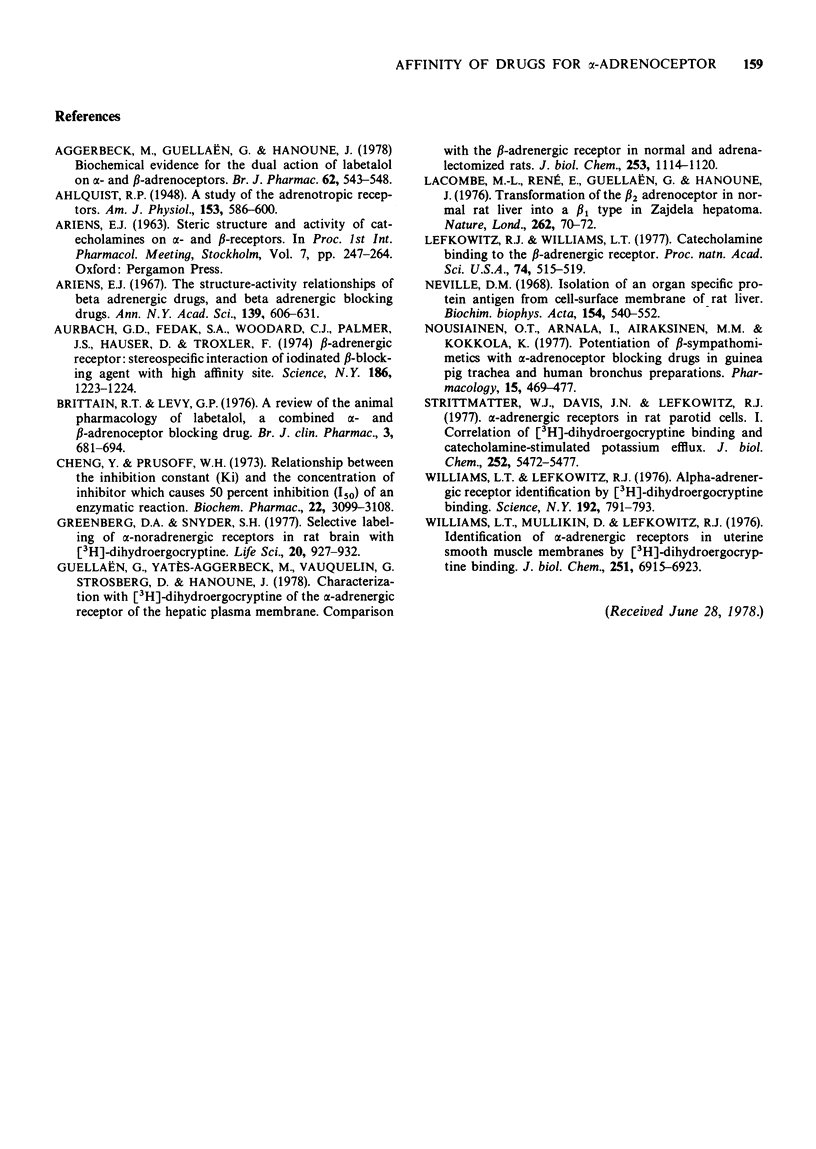
Selected References
These references are in PubMed. This may not be the complete list of references from this article.
- Aggerbeck M., Guellaen G., Hanoune J. Biochemical evidence for the dual action of labetalol on alpha- and beta-adrenoceptors. Br J Pharmacol. 1978 Apr;62(4):543–548. doi: 10.1111/j.1476-5381.1978.tb07759.x. [DOI] [PMC free article] [PubMed] [Google Scholar]
- Ariëns E. J. The structure-activity relationships of beta adrenergic drugs and beta adrenergic blocking drugs. Ann N Y Acad Sci. 1967 Feb 10;139(3):606–631. doi: 10.1111/j.1749-6632.1967.tb41232.x. [DOI] [PubMed] [Google Scholar]
- Aurbach G. D., Fedak S. A., Woodard C. J., Palmer J. S., Hauser D., Troxler F. Beta-adrenergic receptor: stereospecific interaction of iodinated beta-blocking agent with high affinity site. Science. 1974 Dec 27;186(4170):1223–1224. doi: 10.1126/science.186.4170.1223. [DOI] [PubMed] [Google Scholar]
- Brittain R. T., Levy G. P. A review of the animal pharmacology of labetalol, a combined alpha- and beta-adrenoceptor-blocking drug. Br J Clin Pharmacol. 1976 Aug;3(4 Suppl 3):681–684. [PubMed] [Google Scholar]
- Cheng Y., Prusoff W. H. Relationship between the inhibition constant (K1) and the concentration of inhibitor which causes 50 per cent inhibition (I50) of an enzymatic reaction. Biochem Pharmacol. 1973 Dec 1;22(23):3099–3108. doi: 10.1016/0006-2952(73)90196-2. [DOI] [PubMed] [Google Scholar]
- Greenberg D. A., Snyder S. H. Selective labeling of alpha-noradrenergic receptors in rat brain with [3H]dihydroergokryptine. Life Sci. 1977 Mar 15;20(6):927–931. doi: 10.1016/0024-3205(77)90277-6. [DOI] [PubMed] [Google Scholar]
- Guellaen G., Yates-Aggerbeck M., Vauquelin G., Strosberg D., Hanoune J. Characterization with [3H] dihydroergocryptine of the alpha-adrenergic receptor of the hepatic plasma membrane. Comparison with the beta-adrenergic receptor in normal and adrenalectomized rats. J Biol Chem. 1978 Feb 25;253(4):1114–1120. [PubMed] [Google Scholar]
- Lacombe M. L., Rene E., Guellaen G., Hanoune J. Transformation of the beta2 adrenoceptor in normal rat liver into a beta1 type in Zajdela hepatoma. Nature. 1976 Jul 1;262(5563):70–72. doi: 10.1038/262070a0. [DOI] [PubMed] [Google Scholar]
- Lefkowitz R. J., Williams L. T. Catecholamine binding to the beta-adrenergic receptor. Proc Natl Acad Sci U S A. 1977 Feb;74(2):515–519. doi: 10.1073/pnas.74.2.515. [DOI] [PMC free article] [PubMed] [Google Scholar]
- Neville D. M., Jr Isolation of an organ specific protein antigen from cell-surface membrane of rat liver. Biochim Biophys Acta. 1968 Apr 9;154(3):540–552. doi: 10.1016/0005-2795(68)90014-7. [DOI] [PubMed] [Google Scholar]
- Nousiainen O. T., Arnala I., Airaksinen M. M., Kokkola K. Potentiation of beta-sympathomimetics with alpha-adrenoceptor blocking drugs in guinea pig trachea and human bronchus preparations. Pharmacology. 1977;15(5):469–477. doi: 10.1159/000136723. [DOI] [PubMed] [Google Scholar]
- Strittmatter W. J., Davis J. N., Lefkowitz R. J. alpha-Adrenergic receptors in rat parotid cells. I. Correlation of [3H]dihydroergocryptine binding and catecholamine-stimulated potassium efflux. J Biol Chem. 1977 Aug 10;252(15):5472–5477. [PubMed] [Google Scholar]
- Williams L. T., Lefkowitz R. J. Alpha-adrenergic receptor identification by (3H)dihydroergocryptine binding. Science. 1976 May 21;192(4241):791–793. doi: 10.1126/science.4894. [DOI] [PubMed] [Google Scholar]
- Williams L. T., Mullikin D., Lefkowitz R. J. Identification of alpha-adrenergic receptors in uterine smooth muscle membranes by [3H]dihydroergocryptine binding. J Biol Chem. 1976 Nov 25;251(22):6915–6923. [PubMed] [Google Scholar]


